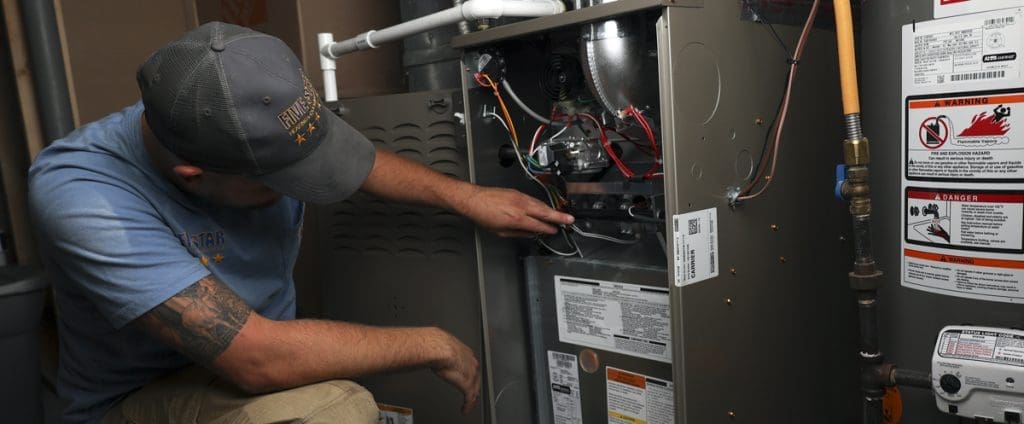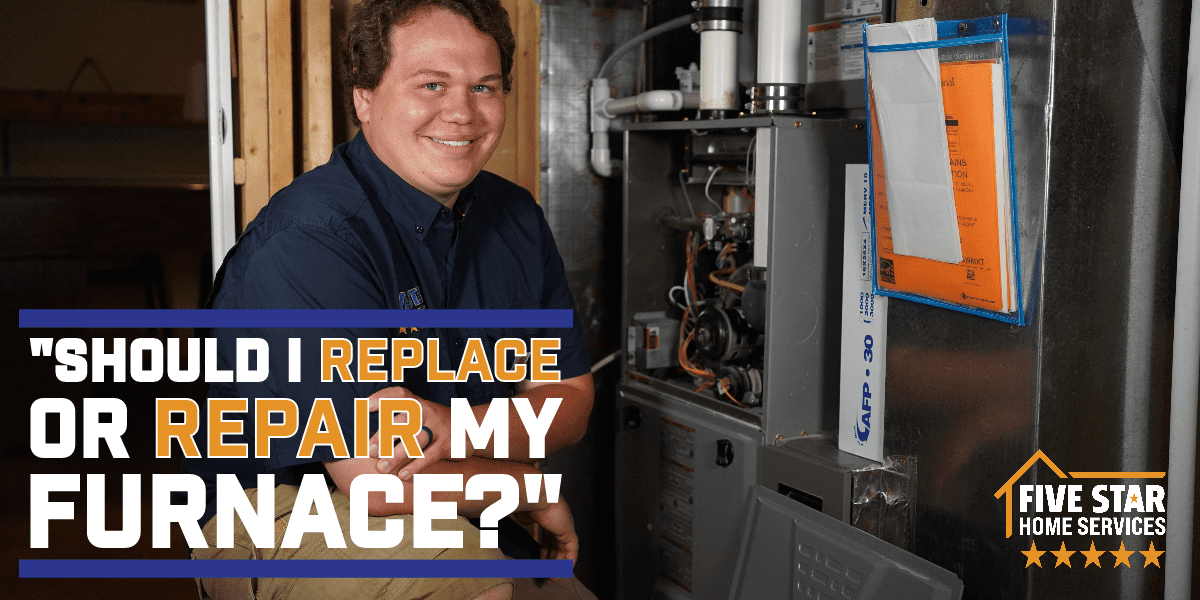Decisions. Decisions.
Wouldn’t it be nice if every decision we made in life was clearly black and white? Unfortunately, we occasionally face those gray areas when it comes to home comfort equipment.
Because deciding whether to repair or replace your furnace can be stressful, we at Five Star Home Services like to help you simplify things. This article covers factors that can help you decide whether it’s time to repair or replace your furnace.

The last thing we want on a cold winter night is to wake up without heat. Burrrrrr… So, what should you do when your furnace stops working? You could try to troubleshoot it on your own. However, that can be tricky if you aren’t familiar with HVAC equipment. You could try calling your friendly HVAC provider at Five Star Home Services. With our excellent training and expertise, surely, we can fix it, right?
Unfortunately, sometimes our service technicians have to be the bringer of bad news: Your furnace needs a major repair to get it up and running again. That’s where our installation experts come in. We have decades of experience as HVAC service technicians. We’ve worked with thousands of customers who are trying to make this challenging decision. Whether you decide to replace or repair, we have your best interest.
In the following article, we will break down this difficult decision the way we would for any one of our amazing customers. We’ll look at the costs of the repair for your existing system in addition to its age. We will also discuss the cost of a replacement furnace.
After reading this article, you’ll have the information to decide between replacing and repairing your furnace.

Repairing vs. Replacing Your Furnace
If you are facing this decision, let us first say this is rarely easy. Although service technicians can make great suggestions, the decision is ultimately yours. Sometimes, we look at HVAC equipment as a sick patient — it’s our job to figure out what the equipment needs and how to get it back on its feet working like it used to once again. Nevertheless, we also recognize that it often makes no sense to repair an older furnace that is only going to continue causing problems! It’s going to need to be replaced sooner or later!
From our service technician’s perspective, whether you decide to replace or repair your furnace depends on several factors. Those factors include the following:
- The age of your HVAC system
- Your comfort and budget goals
- The cost of the repair vs. the cost of a replacement
How Much Does It Cost to Repair a Furnace?
Furnace repair costs vary based on a few factors as well, including:
- The amount of time it takes to make the repair
- The cost of the replacement part
- The type of system you have
A modern furnace can last 15-20 years or longer when properly installed and consistently maintained. Nevertheless, within your furnace’s lifespan, you may have to make repairs or replace some parts. For the most part, we separate these parts into two categories: Major and minor furnace repairs. We’ll discuss the various costs of these repairs, the lifespan of each part, and the time it takes to make the repairs below.
Sometimes, a simple repair only requires replacing a part. However, sometimes repairing certain parts isn’t cost-effective. Although the final decision rests upon you, our HVAC service technicians can provide valuable recommendations based on your needs and situation. Minor furnace repairs are less intensive. These repairs typically take less time to repair and may be less expensive than some major repairs. Typically, you won’t have to replace your furnace if a minor repair gets it working properly again.
Some of the furnace repairs we consider minor include the following:
- Ignitor replacements
- Sequencer replacements
- Transformer replacements
- Pressure switch replacements
Major furnace repairs, on the other hand, can require much more time, expertise, and labor. These repairs address major issues that can completely inhibit or at the very least, severely limit your system’s overall performance. Because of this, it can often be a lot more cost-effective to replace your furnace rather than have an expensive major repair performed.
The most common major furnace repairs include the following:
- Circuit board replacements
- Blower motor replacements
- Gas valve replacements
- Inducer motor replacements
- Heat exchanger repairs and replacements
Next, we will break these repairs down. We will now discuss each part’s role, the repair’s cost, and its life expectancy. The price ranges we have listed below include the cost of the part, fees, and labor. The prices we have listed below may seem higher than other guides because those guides only list the cost of the part.

Furnace Pressure Switch Replacements
Furnaces usually have multiple safety switches. However, furnace pressure switches are far more likely to fail than most of the other safety switches. Nevertheless, furnace pressure switches can have a life expectancy of about ten years.
Furnace pressure switch replacements usually cost between $250 – $350.
Furnace Ignitor Replacements
A furnace’s ignitor is what gives it the spark to heat your home. Most modern ignitors have a life expectancy of anywhere from 5 to 15 years, depending on the type of ignitor your furnace has.
Furnace ignitor replacements usually cost around $250- $300.
Electric Furnace Sequencer Replacements
If you have an electric furnace that isn’t heating your home, there might be a problem with the sequencers. Sequencers are what help power the heat strips in electric furnaces. Heat strips almost never fail. However, sequencers can have a life expectancy of 12 to 15 years.
Sequencer replacements for electric furnaces usually cost around $250 – $350.
Furnace Transformer Replacements
Your furnace’s transformer is what supplies electricity to your home heating system. Furnace transformers, nevertheless, rarely fail. When they fail, however, it is likely caused by electrical stress on your furnace, such as short cycling. Despite this, most furnace transformers last as long as your furnace.
When they fail, furnace transformer replacements usually cost around $300.
Gas Valve Replacements
Gas valves provide furnaces fuel. They usually last as long as your furnace last and don’t need to be replaced until you replace it. The final cost of a gas valve replacement depends on the type of gas valve you need. Your heating system’s staging affects the type of gas valve you need. Staging refers to the number of capacity settings on your gas valve. It allows your furnace to adjust its heating outputs.
There are three types of gas valves:
- Single-stage
- Two-stage
- Modulating
Gas valves usually have low rates of failure. Nevertheless, when they do finally fail — the complexity of the furnace’s gas valve affects replacement costs. On average, single-stage and two-stage gas valve replacements vary from $600 to $800. Nevertheless, because of their complexity, modulating gas valves can cost up to $800 to $1,100. If the gas valve that your furnace needs is no longer manufactured, this can also increase the cost.
Furnace Circuit Board Replacement
Circuit boards tell the rest of your furnace how to do its job. They also keep your furnace on track in the home heating cycle. The life expectancy of a circuit board depends on several factors.
Moisture is the top reason for circuit board failure. The life expectancy of your furnace’s circuit board significantly decreases when there’s moisture in areas where your system is located.
Furnace circuit board replacement costs vary from $650 to $1,800, depending on how complex your system is. If you have issues with excess moisture or humidity, installing a dehumidifier can help.
Furnace Inducer Motor Replacement
Inducer motors move air within furnaces. They have two major roles:
- They move air through the heating process inside your furnace
- Exhausting waste gases, such as carbon monoxide, through flue pipes
Inducer motors have a life expectancy on average of 12 to 15 years. Replacement inducer motors cost up to $700 to $1,600.
Furnace Blower Motor Replacement
Blower motors circulate heated air throughout the home. Without them, HVAC systems aren’t able to effectively distribute air to all the rooms in the home and provide comfort throughout.
The type of blower motor you have can affect its life expectancy. Older heating systems usually have permanent-split compressor (PSC) blower motors. They are relatively simple and fairly inexpensive to produce. Their life expectancy varies from 10 to 12 years.
Replacement PSC blower motors start at $700 – $900 to replace.
On the other hand, variable-speed blower motors have a much longer life expectancy. Variable-speed blower motors have a variety of speed settings offering much more control over your system. Variable-speed blower motors have a life expectancy of 15 to 20 years. When they do eventually break down, they cost more to replace than PSC motors. Because of their complexity, variable-speed blower motors can vary in cost from $1,700 to $2,000 when it comes to replacement.
Heat Exchanger Repairs and Replacements
Heat exchangers play an essential role in keeping your home heated. During a heating cycle, they heat the air. Then, the blower motor distributes what it has heated throughout the home. Heat exchangers have an average life expectancy of 20 years. Nevertheless, this life expectancy can decrease significantly if the rest of your system is strained. When a heat exchanger cracks, it is usually because of building issues.
Additionally, dust, dirt, and clogged air filters can strain your system by increasing static pressure or airflow resistance. Dirt, dust, and clogged air filters also cause systems to overheat. One way to prevent this is to replace your air filters and regularly schedule professional maintenance. Air filters should be checked every month and replaced as often as needed, and maintenance should be performed every year in the fall.
In any case, overheating is hard on heat exchangers. These expensive units heat up and cool down hundreds of thousands of times during their average life. When a heat exchanger overheats, it can become more brittle, resulting in cracking.
Although it’s possible to repair a heat exchanger, these repairs can cost up to thousands of dollars. Heat exchangers are located behind all the other parts. In order to work on your heat exchanger, a technician will have to take the furnace apart. This is labor-intensive and takes a lot of skill and a lot of time. Technicians must be highly skilled and very professional in evaluating and repairing heat exchangers.
Replacing heat exchangers is also equally labor-intensive. Replacement heat exchangers cost anywhere from $1,000 to $2,000 when under warranty. If the furnace is not under warranty, your heat exchanger could cost as much as $3,500 to replace. In these cases, we recommend replacing the furnace altogether, especially when it is older.
How Much Does a Replacement Furnace Cost?
Now to get down to business. In the following, we will discuss some of the various costs and the factors affecting costs associated with a new furnace. Furnace replacement (or new furnace installation) usually costs between $4,000 to $9,000. This also includes the cost of labor and other fees.
The overall cost of a furnace replacement varies according to the following factors:
- Sizing
- Staging
- Efficiency
Why Your Furnace’s Age Matters
Homeowners need to seriously consider the age of their furnace when making this all-too-essential decision on whether to repair or replace it. Most modern furnaces have a life expectancy of somewhere between 15 and 20 years. Well-maintained furnaces, on the other hand, can last longer than that.
Furnaces under ten years old rarely need repairs. Nevertheless, as your furnace nears the end of its life expectancy, it’s usually no longer cost-effective to continue repairing it. Furnaces approaching 20 years old will probably need to be replaced it in the near future, regardless. So why continue throwing money in it when we can install a new high-efficiency furnace that can pay for itself over time in energy savings?
We typically recommend investing your money in replacements rather than pushing a total breakdown off for a little longer.
When to Repair and When to Replace Your Furnace
Now that you are aware of these factors let’s discuss how they can influence your decision.
Because this decision is always up to you, our job, as your friendly local HVAC partner, is to present you with all your options so you can make the best decision for you, your family, and your home.
If your furnace is less than ten years old and requires a major repair, it is likely a sign that your system is under serious strain.
Factors that can create this strain include:
- Improper installation
- Manufacturer defect
- Irregular (or lack of) maintenance
Although it is normal for parts to fail in older systems, you need to weigh your options at some point. For example, imagine your heat exchanger cracks. It’s probably not very cost-effective to invest thousands of dollars in repairing or replacing it. Especially when your system is approaching the end of its lifespan.
As we discussed earlier, heat exchangers cost upwards of $3,500 to replace. That’s a lot of money. Look at the cost of installing a better, newer furnace first. Repairs can sometimes be more than the cost of furnace replacement. If you have an older furnace, this is not the best use of your money. All too often, furnace repair is not the most cost-effective decision.
Discover the ultimate reason why knowing the cost of a new furnace is always a smart move. By understanding the price of your ideal system, you’ll be able to make a well-informed decision on whether repairing or replacing your furnace is truly a cost-effective choice.
Additional Steps
If you’re looking for a more detailed, in-depth breakdown of the cost of a replacement furnace, give us a call! If you’d like one of our HVAC professionals to assess your current furnace, we’d be happy to help!
At Five Star Home Services, we always do the right thing for our fabulous customers. We present you will all the options to educate you on all possible solutions. This way, you make the most informed decision. Our service technicians and sales professionals are available to give you the information you need so you can identify which option is the best for you.


